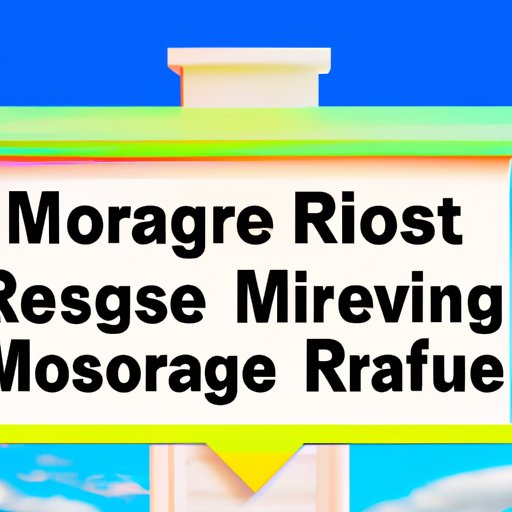
Introduction
Reverse mortgages have become increasingly popular in recent years as retirees seek ways to supplement their income without having to sell their homes. However, the payouts from a reverse mortgage can vary widely depending on numerous factors. It’s important to have a thorough understanding of reverse mortgage payouts before deciding if this financial product is right for you.
Comprehensive Guide to Understanding Reverse Mortgage Payouts
What is a reverse mortgage?
A reverse mortgage is a type of loan available to homeowners over the age of 62. Rather than making payments to a lender as with a traditional mortgage, the lender makes payments to the borrower. Reverse mortgages allow retirees to tap into their home equity as a source of income without having to sell their homes.
How does a reverse mortgage work?
Reverse mortgages are complex financial products, but they typically work as follows: the lender makes payments to the borrower based on their home equity, which is the difference between the market value of the home and any outstanding mortgage balances. The borrower can choose to receive payments in the form of a lump sum, a line of credit, or in monthly payments. The loan comes due when the borrower sells the house, moves out or passes away.
Types of reverse mortgages
There are three main types of reverse mortgages: home equity conversion mortgages (HECMs), proprietary reverse mortgages, and single-purpose reverse mortgages. HECMs are the most common and are considered the safest option because they are insured by the federal government. Proprietary reverse mortgages are offered by private lenders and can be useful for those with high-value homes. Single-purpose reverse mortgages are typically offered by state and local governments and are designed specifically for low-income homeowners who need help paying for home repairs or property taxes.
Repaying a reverse mortgage
When a borrower passes away or sells their home, the loan comes due. Typically, the borrower or their heirs can choose to sell the home to repay the loan or repay the loan with other funds. If the home is sold for more than the loan balance, the borrower or their heirs will receive the difference.
Eligibility requirements
To be eligible for a reverse mortgage, borrowers must be at least 62 years old and have a significant amount of equity in their home. The specific equity requirements vary depending on the lender and the type of reverse mortgage.
Breaking Down the Costs and Benefits of a Reverse Mortgage
Costs involved in a reverse mortgage
Reverse mortgages come with a number of costs, including closing costs, origination fees, and mortgage insurance premiums. These costs can add up quickly, so it’s important to fully understand them before deciding if a reverse mortgage is right for you.
Benefits of a reverse mortgage
The main benefit of a reverse mortgage is that it allows retirees to tap into their home equity for income without having to sell their homes. This can be a valuable source of income for those who need it. Additionally, reverse mortgages typically do not have to be repaid until the borrower passes away or sells their home.
Revealing the Exact Amount of Money You Can Get from a Reverse Mortgage
Factors that determine reverse mortgage payouts
The amount of money that a borrower can receive from a reverse mortgage depends on a number of factors, including the value of their home, the interest rate on the loan, and the age of the borrower. Generally, the older the borrower and the more valuable their home, the higher the potential payout.
Examples of potential payout scenarios
Exact reverse mortgage payouts can be difficult to predict because they are dependent on so many factors. However, as an example, a 75-year-old borrower with a home worth $500,000 might be able to receive a lump sum payment of around $225,000 from a reverse mortgage.
Understanding the Factors that Impact Reverse Mortgage Disbursements
Interest rates
The interest rate on a reverse mortgage will impact the amount of the monthly payment or line of credit available. Higher interest rates mean lower payouts.
Home value
The value of the home directly impacts the amount of equity that a borrower can access. More valuable homes have higher potential payouts.
Age of the borrower
The older the borrower, the higher the potential payout. This is because the lender expects to receive payment from the sale of the home later in life, and the borrower’s age is an indicator of their expected longevity.
Loan duration
The longer the loan is outstanding, the less equity the borrower will have left in their home. This means that loans with longer terms and higher interest rates will result in lower payouts.
How to Calculate How Much You Are Eligible to Receive with a Reverse Mortgage
Calculation process
Calculating your potential reverse mortgage payout requires a complex formula that takes into account numerous factors including your age, the value of your home, and the interest rate on the loan. There are numerous online calculators available that can help you estimate your potential payout.
Resources available for assistance
If you’re considering a reverse mortgage but are unsure about how much you may be eligible for, many lenders offer free consultations that can help you understand your potential payout. Additionally, there are a number of independent financial advisors and nonprofit organizations that can provide guidance.

Tips for Optimizing Your Reverse Mortgage Payout
Exploring payout options
Reverse mortgages offer a few different payout options, including lump sum, line of credit, and monthly payments. It’s important to understand the pros and cons of each option and choose the one that best fits your financial needs.
Leveraging your home equity
Borrowers can choose to receive payouts in the form of a lump sum or line of credit, which can then be invested to earn additional income. This can be a good way to boost your overall financial security.
Minimizing unnecessary expenses
Reverse mortgages can be expensive, with closing costs and other fees adding up quickly. By minimizing these expenses, borrowers can maximize their payouts and overall financial benefits.
Debunking Common Misconceptions About Reverse Mortgage Payments
Myths and misconceptions
There are a number of myths and misconceptions surrounding reverse mortgages, including beliefs that borrowers lose ownership of their homes, that the loan is due immediately upon death, and that borrowers cannot refinance or sell their homes. These misconceptions can prevent people from taking advantage of reverse mortgages.
Clearing up misunderstandings
Despite the misconceptions surrounding reverse mortgages, they can be a valuable tool for retirees looking to supplement their income and stay in their homes. By understanding the facts about reverse mortgages, borrowers can make informed decisions about their financial futures.
Conclusion
Reverse mortgages can be a valuable tool for retirees looking to supplement their income without having to sell their homes. However, understanding reverse mortgage payouts requires a thorough understanding of the numerous factors that impact them. By following the tips and guidance outlined in this guide, readers can make informed decisions about whether a reverse mortgage is right for them.





